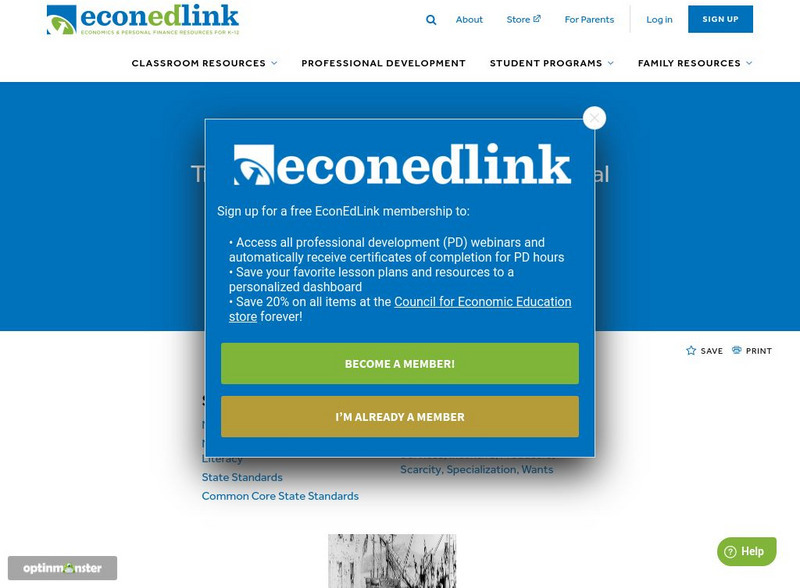Council for Economic Education
Econ Ed Link: The Best Deal
Students will learn how to determine 'price per unit' to help make decisions when comparing products.
Council for Economic Education
Econ Ed Link: Be an Energy Saver
This instructional activity focuses on the scarce and non-renewable nature of fossil fuels in order to stimulate student thinking about energy conservation. It emphasizes the fact that saving energy can be good for the wallet as well as...
Council for Economic Education
Econ Ed Link: Believe It or Not?
This instructional activity reveals to students how advertisers use words and images to make goods and services look their best. To protect consumers and make sure that competition among sellers is fair in the marketplace, the federal...
Council for Economic Education
Econ Ed Link: It's a Matter of Power
Students examine tradeoffs and profit- maximization decisions in the case study of Kaiser Aluminum, which decided to shut down aluminum production in favor of reselling electricity.
Council for Economic Education
Econ Ed Link: Trouble Is Brewing in Boston: "Colonial Voices Hear Them Speak"
It's December 16, 1773 and many of the citizens of Boston are furious with King George's new tax on tea. Young Ethan, a printer's errand boy, has been given the task of conveying information concerning an upcoming protest meeting. As he...
Council for Economic Education
Econ Ed Link: Clipping Coupons
In this lesson, students will calculate savings for different products when using coupons. They will also decide what factors will influence the choices they make when choosing products.
Council for Economic Education
Econ Ed Link: Giving Credit
This lesson plan introduces the role and importance of the 3 C's - capacity, character, and collateral - to being granted credit. An online story about a girl who fails to return soccer shin guards borrowed from a friend is used to spark...
Council for Economic Education
Econ Ed Link: A Penny Saved Is a Penny at 4.7% Earned
There are lots of ways to receive income, and lots of ways to spend it. In this EconomicsMinute you will develop two budgets to help you decide how to allocate your income. Assuming you do not love making dollar bill rings.
Council for Economic Education
Econ Ed Link: Guess Who's Coming to Dinner
This lesson introduces regulation and information as two tools used by government to promote fair competition and complete information in a market economy. Using the 1906 Pure Food and Drugs Act as a case study, students explore the...
Council for Economic Education
Econ Ed Link: Cost/benefit Analysis: Three Gorges Dam
This lesson will allow middle schoolers to evaluate the costs/benefits of the Three Gorges Dam project on the Yangtze River in China. The purpose of this lesson is to encourage students to look at a complex issue from differing...
Council for Economic Education
Econ Ed Link: The Costs of Credit
"Will that be cash, check, debit, or credit?" This lesson plan explores the difference between these. What is the difference? Is using credit the same as paying with cash? Or by check? Or by debit card? Some young people believe that...
Council for Economic Education
Econ Ed Link: Every Penny Counts
Lesson that helps young scholars understand that people must make choices about the goods and services they purchase. Students recognize the prices indicate what people pay for goods and services, learn to compare prices, and understand...
Council for Economic Education
Econ Ed Link: Economic Spotter: Resources During World War Ii
In World War II pennies were made of steel and zinc instead of copper and women were working at jobs that men had always been hired to do. Why? Because during war times, scarcity forces many things to change!
Council for Economic Education
Econ Ed Link: The Choice Is Us: Monopolies
This lesson introduces the concept of monopoly. It calls upon students to consider how monopoly power might affect the quality and price of goods and services offered to consumers. In light of what they learn about the history of trusts...
Alabama Learning Exchange
Alex: Liquidity for Success
This instructional activity will input values to calculate financial ratios and intepret the information derived from the calculations. This is a Commerce and Information Technology lesson plan.
Council for Economic Education
Econ Ed Link: On the Money
In this lesson, students explore what money is and how it differs around the world. They will compare U.S. currency with play money and with foreign currency. They will then use their knowledge to design their own money.








